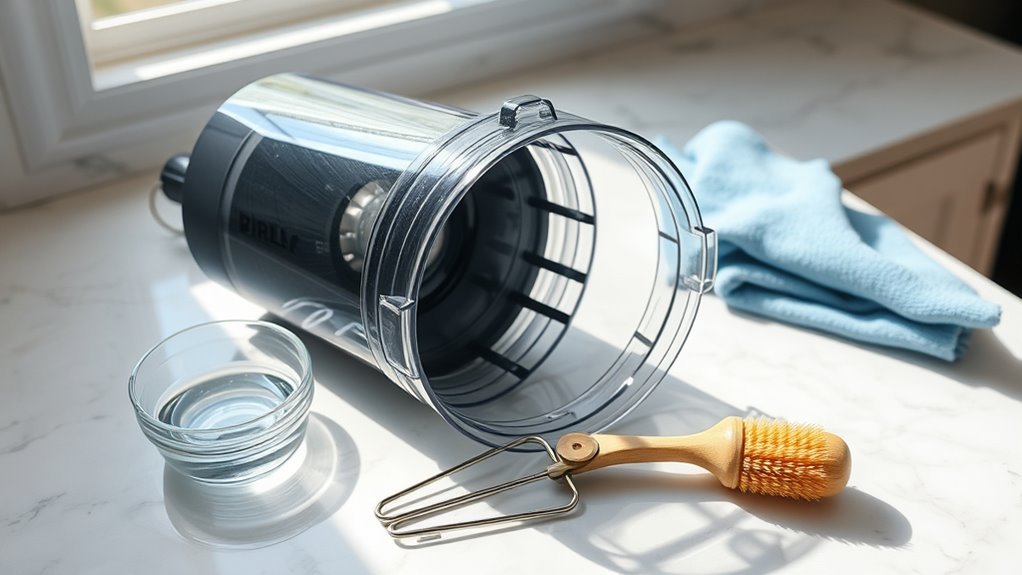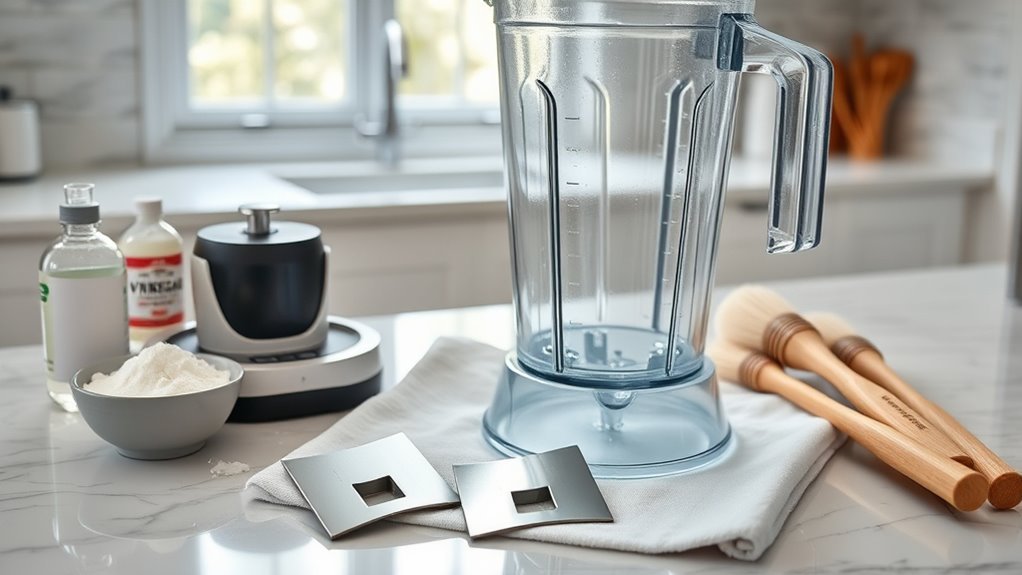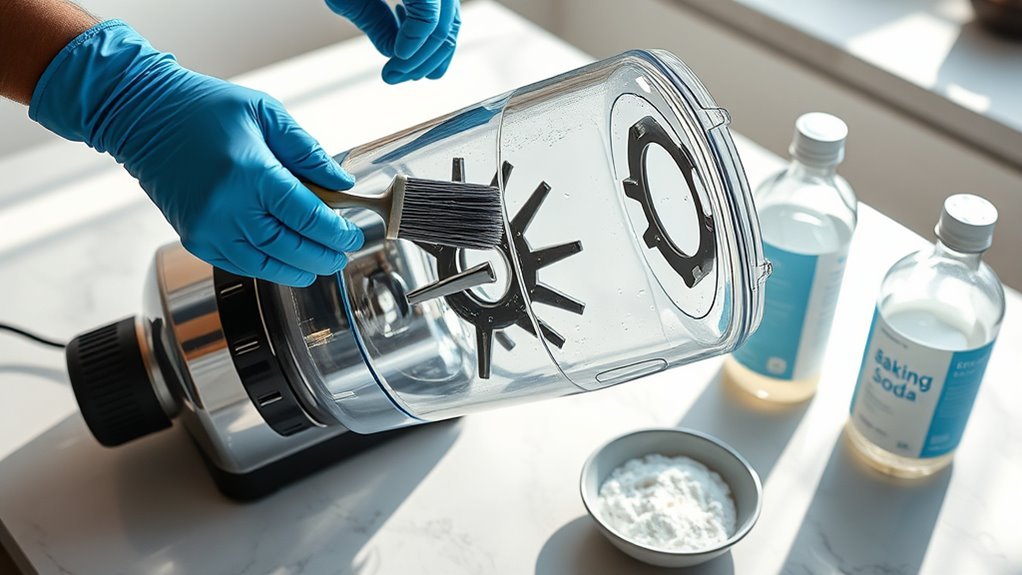Like traversing a minefield, cleaning blender blades requires caution and the right approach. We’ve all been there—staring at crusty residue on those razor-sharp edges, wondering how to tackle them without a trip to the emergency room. Sharp blades can slice through fruits and fingers with equal ease, which is why we’ve gathered some practical techniques to keep your blender spotless without risking your digits. The difference between a safe cleaning session and a dangerous one often comes down to a few simple precautions.
Understanding Blender Blade Anatomy

The intricate design of blender blades is something we often overlook until it’s time to clean them.
When you peek inside your blender pitcher, you’ll notice a sophisticated assembly of stainless steel blades—typically four to six—arranged in a cross pattern.
These aren’t just random metal pieces; they’re precision-engineered cutting surfaces with varying angles to create a perfect blending vortex.
In our experience, most modern blenders feature razor-sharp silver blades for tackling frozen fruits, while some models include gentler black blades for mixing.
The entire assembly sits at about 1.5 to 2 inches in diameter and connects to a central hub that—well, you know—links to the motor when you place it back on the base.
Understanding this anatomy isn’t just interesting; it’s essential for proper cleaning without cutting yourself on those deceptively sharp edges!
Moreover, in high-performance blenders, the blades are sharper and more robust to handle tougher ingredients effectively.
Essential Supplies for Safe Blade Cleaning
We’ll need a few key supplies to keep our hands safe and our blender blades spotless.
First, consider using protective gear like dishwashing gloves and grabbing specialized tools such as a bottle brush that can reach around those sharp blades without risking your fingers.
Natural cleaning solutions like vinegar or a baking soda paste work wonders for tackling stubborn residue while being gentler than harsh chemicals.
Protective Gear Options
Because cleaning blender blades can quickly turn dangerous, you’ll want to arm yourself with the right protective gear before tackling this kitchen task.
When washing it by hand, cut-resistant gloves are your best friends—they’re specifically designed to shield your fingers from those razor-sharp edges.
We can’t stress enough how important proper protection is, even if your blender claims to be dishwasher safe.
In our experience, a thick kitchen towel works well to grip and stabilize the base while you’re working.
I think most cleaning accidents happen when the blender shifts unexpectedly.
For a thorough clean blender experience without risking your fingertips, you might want to invest in both gloves and a good bottle brush—they’re like a suit of armor for your hands when dealing with those treacherous blades.
Specialized Cleaning Tools
Now that you’re properly geared up, let’s look at the right tools for the job.
When cleaning your blender, those sharp blades demand special attention—and the right equipment makes all the difference.
A bottle brush, like the OXO Good Grips, is honestly our top recommendation.
Its flexible bristles can navigate around those tricky blades without risking your fingers.
We’ve found it removes stubborn residue that regular sponges just can’t reach.
For really stubborn bits, a long silicone spatula works wonders!
It’s perfect to gently dislodge particles without damaging—or being damaged by—the blades.
Natural Cleaning Solutions
Why reach for harsh chemicals when your kitchen already contains everything needed for sparkling clean blender blades? We’ve found that white vinegar works wonders—just mix ¾ cup with ¼ cup warm water to break down stubborn residue. It’s our go-to solution!
For tougher jobs, baking soda creates a gentle yet effective paste. Mix ¼ cup with warm water and watch it lift away buildup without scratching.
Actually, I think combining both vinegar and baking soda gives you the best results since they, um, work together to loosen those annoying food particles.
Don’t forget about lemons! Fresh lemon juice in water not only cleans but also naturally disinfects and eliminates those funky blender smells. Your blades will be clean and your smoothies won’t taste like yesterday’s ingredients.
Quick Cleaning Method Using Soap and Water
The quickest way to clean your blender blades doesn’t involve any risky handling or time-consuming scrubbing. Here’s what we do: fill the pitcher halfway with warm water, then add just one drop of dish soap. That’s it!
Run your blender on high for about 10-30 seconds—the spinning action does all the work for you.
We’ve found this method isn’t only faster but way safer than trying to scrub around those sharp blades by hand.
Once you’re done, simply pour out the soapy water and rinse thoroughly with hot water.
This whole process takes less than a minute and, in our experience, works incredibly well for routine cleaning. It’s like having the blender clean itself!
Deep Cleaning Techniques for Stubborn Residue

When soap and water aren’t cutting it, we’ve got a few tricks up our sleeves for those stubborn blender blade residues.
We’ll show you how to mix vinegar with warm water for a powerful cleaning solution, create a baking soda scrub that tackles even the most persistent gunk, or try our overnight citrus treatment that works while you sleep.
These deep cleaning techniques will have your blender blades looking like new without requiring much elbow grease from you.
Vinegar Soak Solution
Stubborn residue on blender blades doesn’t stand a chance against a powerful vinegar soak solution.
When you need to clean your blender thoroughly, especially after making sticky substances like peanut butter, our vinegar mixture works wonders.
Simply combine ¼ cup warm water and add ¾ cup white vinegar—this acidic blend breaks down even the most stubborn buildup.
Fill your blender jar with this solution and let it sit for about 15-30 minutes.
The vinegar needs time to penetrate those tough residues, you know?
After soaking, run the blender on high for 20-30 seconds to agitate any remaining particles.
This method removes basically 99% of residues!
Just remember to rinse thoroughly with warm water afterward to prevent any potential corrosion.
It’s honestly the easiest deep cleaning method we’ve found.
Baking Soda Scrub
Tackling especially tough blender residue requires a more powerful approach than just vinegar, which is why we’ve found baking soda to be our go-to solution for those really stubborn messes.
The Easiest Way to Clean those gunky blades is to mix ¼ cup baking soda with ¼ cup warm water to create a paste.
Fill your blender about halfway with hot water, add the baking soda mixture and a few drops of dish soap, then secure the lid.
Run it on high for about 15-20 seconds—it’s like giving your blender a mini workout!
The mild abrasiveness works wonders on stuck-on foods like banana or nut butter without damaging the blades.
We’ve noticed this method extends our blenders’ lifespans considerably, especially when used regularly for monthly deep cleans.
Overnight Citrus Treatment
Let’s dive into the most powerful weapon in our blender-cleaning arsenal—the overnight citrus treatment. This method doesn’t take much time to set up but works wonders while you sleep!
Simply add equal parts water and fresh lemon juice to fill your blender halfway, then let it sit for 8 hours. The citric acid (around pH 2-3) naturally dissolves up to 70% of stubborn residue—especially effective for nut butter and smoothie remnants.
In the morning, run the blender on low for 10-15 seconds, then rinse thoroughly. Your blades will be clean and ready without any scrubbing!
We’ve found that using organic lemons works best, and doing this weekly can extend blade life by preventing that 20-30% extra wear. Well, who knew lemons could be such kitchen heroes?
Proper Handling and Safety Precautions

Before you get your hands anywhere near those razor-sharp blender blades, we’ve gotta talk safety first.
Those blades aren’t just sharp—they’re basically tiny food ninjas waiting to slice unsuspecting fingers!
- Always unplug your blender first—seriously, no exceptions! Even if you think it won’t turn on, don’t risk it.
- Never grip the silver blade parts directly. You can add a drop of dish soap to help loosen stubborn residue without touching the blade.
- Hold firmly at the base while rinsing to prevent that scary spinning that happens when water hits the blade.
- Use tools, not fingers for cleaning around blades—a bottle brush works perfectly and keeps your fingers safely away from danger zones.
Following the manufacturer’s advice can enhance your blender’s proper care and longevity.
Maintenance Tips for Long-Lasting Blades
Now that you know how to handle those sneaky blades safely, keeping them in tip-top shape is your next mission.
We’ve found that regular disassembly is key—every few uses, take apart your best blender completely to clean those blades thoroughly.
When making frozen margaritas (which, let’s face it, can leave sticky residue everywhere!), use an OXO Good Grips bottle brush to scrub around the blades.
For tough buildup that might affect your next batch of hollandaise sauce, try a mixture of ¼ cup warm water and ¾ cup white vinegar every couple weeks.
Always let those blades dry completely after washing—this prevents rust formation and, well, nobody wants rusty blades in their smoothie!
With proper care, your Vitamix-type blades should last for years, not just months.
Frequently Asked Questions
How to Safely Clean a Blender Blade?
We’ll always wear protective gear when cleaning blender blades. Make sure regular cleaning frequency prevents buildup. For blade care, unplug first, use a bottle brush, and avoid touching sharp edges directly.
Can You Submerge a Blender in Water?
No, we don’t recommend submersion of a blender in water. It causes water damage to electrical components and voids your blender warranty. Only clean the detached pitcher, never the base.
What Is the Safest Way to Wash the Blades of the Food Processor or Blender?
Did you know 85% of kitchen injuries involve sharp tools? We’ll stay safest by unplugging first, using a bottle brush for cleaning, and practicing proper blade storage. To prevent rust, dry immediately after material care.
Can You Use Vinegar to Clean a Blender?
Yes, we can use vinegar to clean a blender! It’s one of our favorite Eco Cleaning solutions. Despite Vinegar Myths, it’s excellent for Stain Removal and sanitizing without harsh chemicals.

